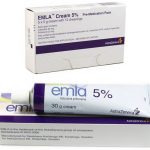- Type of Drug: Topical anesthetic.
- Prescribed for: Prevention of skin pain. EMLA Cream has also been studied for its effects on relieving the pain of intravenous catheter placement, minor plastic and skin surgery, shingles, and injections (such as vaccinations and blood donation).
General Information
EMLA (which stands for Eutectic Mixture of Local Anesthetics) is a mixture of two anesthetics which, when mixed in a certain way, turn to liquid when applied to the skin. The anesthetics penetrate all: layers of skin, deadening nerve endings and providing an anesthetic effect that is as good as that achieved by injecting local anesthetics under the skin. EMLA is effective in preventing virtually any kind of pain that is associated with the skin. It can be used on people of virtually all ages and offers the advantage of preventing pain without injection. The cream must be applied under an occlusive bandage (one that completely shuts out all contact with air or water), which intensifies the contact between the skin and the anesthetic cream. It works after staying on the surface of the skin for at least 1 hour, but may work more effectively if left on for 2 or 3 hours. The anesthetic effect remains for 2 hours after the cream has been removed from the surface of the skin.
Cautions and Warnings
Do not use EMLA Cream if you are allergic to either of the anesthetics in the mixture. People with methemoglobinemia, a rare blood condition, should not use EMLA.
Do not apply EMLA Cream beyond the area prescribed by your doctor. Excessive application of EMLA could put too much local anesthetic in your blood and expose you to the possibility of anesthetic-related side effects. Do not put EMLA in your eyes or ears.
People with severe liver disease should use EMLA with caution because they may have difficulty removing the absorbed anesthetics from their bloodstream.
Possible Side Effects
- Most common: irritation, redness, and swelling of the area to which it is applied.
- Common: skin pallor, patches of white skin, itching, rash, and changes in how you sense skin temperature.
- Rare: severe allergic reactions (itching, rash, swelling, difficulty breathing, and shock) can occur with this product.
In rare cases when too much EMLA is applied, is used too often, or too much anesthetic is absorbed, the following reactions may occur: nervous system excitation, nervousness, apprehension, light-headedness, euphoria (feeling “high”), confusion, dizziness, drowsiness, ringing or buzzing in the ears, blurred or double vision, vomiting, feelings of heat, cold, or numbness, twitching, tremors, convulsions, unconsciousness, or a very slow breathing rate or stopped breathing.
Drug Interactions
Drugs associated with causing methemoglobinemia, should not be taken together with EMLA. This interaction is generally limited to children under 1 year. Some of these drugs are Acetaminophen, sulfa drugs, oral antidiabetes drugs, thiazide diuretics, Phenacetin, Phenobarbital, Phenytoin, Primaquine, and Quinine. Check with your doctor or pharmacist for more information about other methemoglobinemia-causing drugs.
Food Interactions
None known.
Usual Dose
Cream
- Adult and Child (over age 1 month): Apply a thick layer (2 ½ grams or ½ teaspoonful) and cover with the dressing provided in the package or some other occlusive bandage. Leave in place for at least 1 to 2 hours. The cream should .be wiped away immediately before the surgical procedure or injection is done.
- Senior: Avoid multiple uses over a short period of time because of the possibility of drug-induced side effects.
Patch
Apply to designated area and leave in place for at least 1 to 2 hours before removing.
Overdosage
EMLA overdose may affect the heart by making it less efficient. This is directly attributable to the depressant effects of the local anesthetics on the nerves within the heart. This would be more likely only if someone were to swallow an entire tube of EMLA. Call your local poison control center or hospital emergency room for more information. If you go for treatment, ALWAYS bring the medicine container with you.
Special Information
EMLA provides total loss of all feeling from the affected skin; Since there is no feeling in the skin, be careful not to accidentally scratch or burn yourself after the product has been applied.
When you apply the cream, place the entire dose in the center of the area you want to make pain-free. Then cover it with the occlusive dressing and allow the pressure of the dressing to spread the cream around.
Call your doctor if you develop severe, persistent, or unusually bothersome side effects from this product.
If you forget to apply EMLA, do so as soon as you can. But remember, it will still take at least 1 hour from the time you put the cream on your skin to make it numb. Don’t expect any pain relief before then.
Special Populations
Pregnancy/Breast-feeding
There is no evidence that EMLA Cream interferes in any way with fetal development. Nevertheless, you should not use this product during pregnancy unless you have first discussed it with your doctor.
The anesthetics in EMLA Cream pass into breast milk. Watch your infant for possible drug effects if you use EMLA Cream while you are nursing.
Seniors
Seniors may be more sensitive to the effects of drug side effects than younger adults, especially if repeated applications of EMLA are used.

